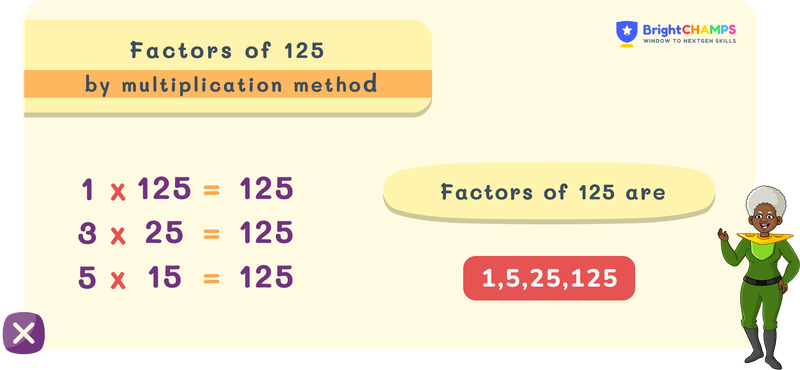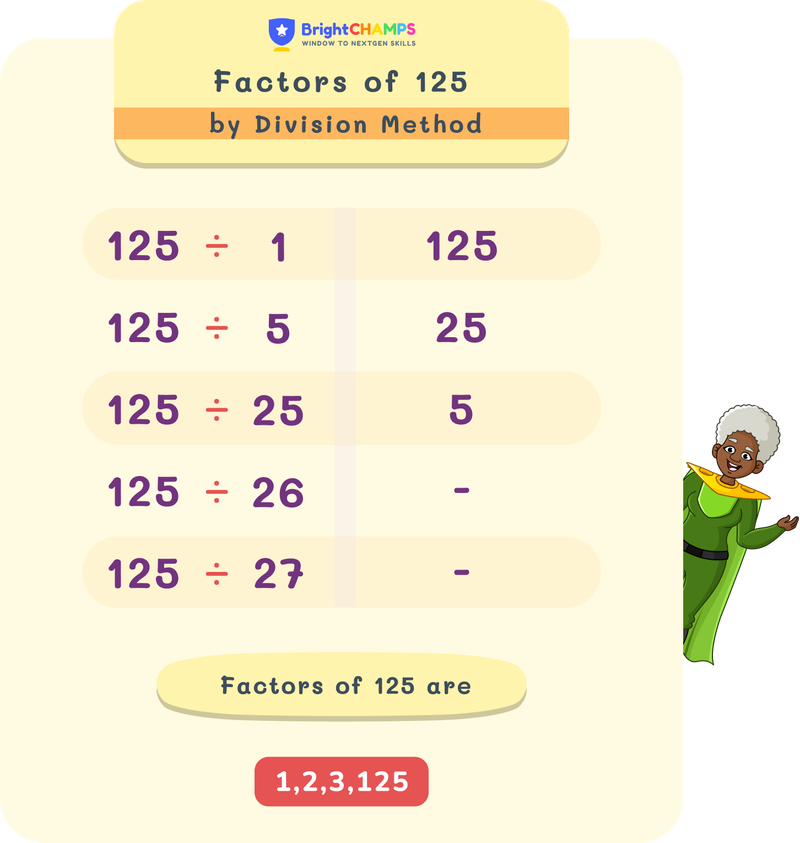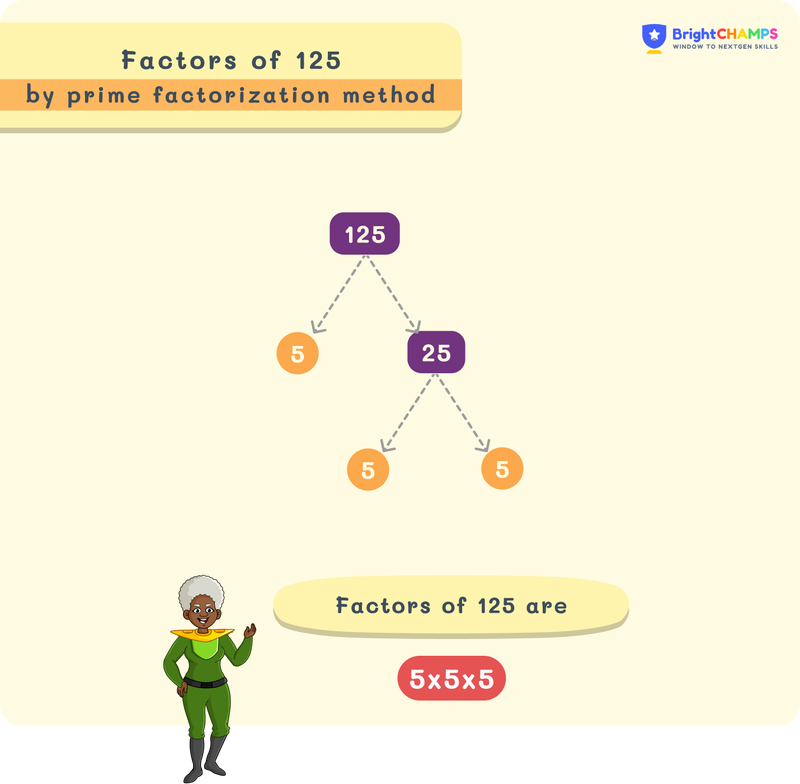Summarize this article:
 690 Learners
690 LearnersLast updated on August 5, 2025
Factors of 125

Do you know how number tricks work? Most of the number tricks work because of the unique characteristics of each number, i.e., factors. A factor of a number is any number that can evenly divide the number. For distributing objects, we use factors in our daily life.

What are the factors of 125.
The numbers which can evenly divide 125 are the factors of 125. 1, 5, 25, 125 are the factors of 125.
Negative factors of 125: The negative factors of 125 are the negative counterparts of the positive factors. -1, -5, -25, -125 are the negative factors of 125.
Prime factors of 125: A prime number is a number which has only two factors, i.e., 1 and the number itself.
5 is the prime factor of 125.
Prime factorization of 125: The process of splitting a number into smaller prime numbers is prime factorization. Here, the product of prime numbers is the number itself.
The prime factorization of 125 is 53

How to find the factors of 125
Factors of a number is a number which can evenly divide the number. Some methods which are used to find the factor of a 125 are,
- Multiplication method
- Division method
- Prime factors and prime factorization
- Factor tree

Finding factors using multiplication method:
In the multiplication method a pair of numbers are identified, the product of multiplying the number is 125.
Step 1: Find the number whose product is 125.
1 × 125 = 125
5 × 25 = 125

Step 2: List them as pairs
The pair of factors are (1, 125), (5, 25)

Finding factors by division method
In the division method, we need to check which number can evenly divide 125.
Let’s check the factors of 125 using division method
125 ÷ 1 = 125
125 ÷ 5 = 25

So, the factors are 1, 5, 25, and 125.

Prime factors and prime factorization
Prime numbers are the numbers which have only two factors. The process of breaking down a large number into a smaller prime number is prime factorization.
To find the factors of a number prime factorization, we need to follow these steps
Step 1: The given number needs to be divided with the smallest prime number.
Step 2: Now, we need to divide the remainder in step 1 with the prime number. The process is continued till the remainder is a prime number.
Let's use the prime factorization method to find the factors of 125.
The prime factor of 125 is 5.
2, 3, 5, 7, 11, 13, 17,… are the prime numbers.
Step 1: Checking the divisibility by 2: 125 is an odd number, so, not divisible by 2.
Checking the divisibility by 3: As the sum of 125 is 8, 8 is not divisible by3. So 125 is not divisible by 3.
Checking divisibility by 5: Dividing 125 with 5
125 ÷ 5 = 25
Step 2: now, the remainder is 25
Checking the divisibility by 5: 25 ÷ 5 = 5
Step 3: Now, the remainder is 5 which is a prime number.
So, the factors of 125 are 1, 5, 25, 125.

Factor tree
The Pictorial representation of factors of a number. It is in the form of a tree where the given number is split into branches which represent all the factors.
The factor tree of 125:


Factor pair
A pair of factors of a number. The product of those numbers is the number itself. Factor pairs can be both positive and negative.
Positive pair factors: (1, 125), (5, 25).
Negative pair factors: (-1, -125), (-5, -25).

Common mistakes and how to avoid them in factors of 125
While finding the factors of any numbers, students tend to make mistakes. Mostly they tend to repeat the same error. Here is a list of some common mistakes and the ways to avoid them

Factors of 125 examples

Problem 1
Calculate the GCF of 125, 225, 245

5 is the GCF of 125, 225, 245.
Explanation
Prime factorization is the method used to find the GCF of 125, 225, 245. 53 is the prime factorization of 125, 32 × 52 is the prime factorization of 225, and 5 × 72 is the prime factorization of 245. Here, the common factor is 5. So, the GCF is 5.

Problem 2
What are the common factors of 125 and 225?

1, 5, and 25 are the common factors of 125 and 225.
Explanation
To find the common factor of 125 and 225 we need to list out the factors of both these numbers. 1, 5, 25, and 125 are the factors of 125. 1, 3, 5, 9, 15, 25, 45, 75, and 225 are the factors of 225. So the common factors are 1, 5, and 25.

Problem 3
Calculate the LCM of 105 and 110

The LCM of 105 and 110 are 2310.
Explanation
The product of the highest power of each prime factor of the number is the LCM.
The prime factorization of 105 is 3 × 5 × 7 and 2 × 5 ×11 is the prime factorization of 110.
The highest power in 105 and 110 are 21, 31, 52, 71, 111
Therefore, the LCM of 105 and 110 is 21, 31, 52, 71, 111
Which is 2 × 3 × 5 × 7 × 11 =2310.

Problem 4
Sum of factors of 125.

156 is the sum of factors of 125
Explanation
The factors of 125 are 1, 5, 25, and 125. Here, the sum of factors is 1 + 5 + 25 + 125 = 156.


FAQs on factors of 125
1.Is 125 an even number
2.List out the first five multiples of 125
3.Is 20 a factor of 125?
4.Find the value of the square root of 125.
5.What is the factor tree of 125

Important glossaries for factors of 125
- Prime number: Any numbers which has only two factors are the prime numbers
- Composite numbers: The number which has more than two factors
- Remainder: The value left after dividing a number by another number. For example, 1 is the remainder when we divide 5 by 2.
- Product: The product of any number is the result of multiplying the number.


Hiralee Lalitkumar Makwana
About the Author
Hiralee Lalitkumar Makwana has almost two years of teaching experience. She is a number ninja as she loves numbers. Her interest in numbers can be seen in the way she cracks math puzzles and hidden patterns.
Fun Fact
: She loves to read number jokes and games.



















